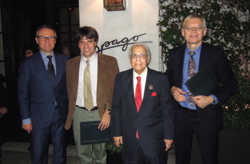Massry Prize for Peter Hegemann
October 28, 2016
The winners of the 2016 Meira and Shaul G. Massry Prize are a trio of scientists — Gero Miesenboeck, Peter Hegemann, and Karl Deisseroth — whose research paved the way for a breakthrough technology called optogenetics that has revolutionized the way scientists study the brain.
Optogenetics allows scientists to turn on and turn off electrical activity in specific brain cells by introducing photosensitive proteins that make them react when exposed to light. Optogenetics made it possible to study the role of specific neurons in both normal brain function and disorders such as Parkinson’s disease, depression and schizophrenia.
The three winners of this year’s Massry Prize gave lectures about their work on October 20, on the Health Sciences Campus of the University of Southern California (USC) in Los Angeles.
“The fundamental findings of Miesenboeck, Hegemann, and Deisseroth, which enabled neuronal function to be controlled through optogenetics, have now become a crucial tool to understand how neurons work, at the single cell and with groups of neurons working together,” said Shaul Massry, MD, professor emeritus of medicine at the Keck School of Medicine of USC. “Scientists all over the world routinely use the optogenetic technology that was developed by these eminent scientists and collaborators. This field has become one of the most interesting and exciting areas of neuroscience.”
The Meira and Shaul G. Massry Foundation established the Massry Prize in 1996 to recognize contributions to the biomedical sciences and the advancement of health. The Prize, of $40,000 and the Massry Lectureship, is bestowed upon scientists who have made substantial recent contributions in the biomedical sciences. Nine out of 24 Awardees have been honoree with a Nobel Prize less than five years after receiving the Massry Prize.
Miesenboeck, MD, a physiology professor at the University of Oxford, was the first to genetically modify a brain cell so that its electrical activity could be controlled with light by altering them with opsin proteins from the retina of a fruit fly.
Hegemann, PhD, professor of biophysics at the Humboldt University of Berlin and member of the Cluster of Excellence UniCat, discovered that green algae possessed a type of light-sensitive molecule that gave it the ability to move toward light in spite of having no eyes and no evidence of opsin receptors. These proteins, called channelrhodopsins, made cells respond to flashes of blue light, converting light into electricity in a single step at the speed of electrical impulses in the brain.
Deisseroth, MD, PhD, professor of bioengineering and of psychiatry and behavioral sciences at Stanford University, combined these findings by introducing channelrhodopsins into the brain cells of mice. Using flashes of light delivered via optic wires inserted into the mouse’s brain, he was able to turn on certain cells in the mouse’s brain that induced specific behaviors.
Hope Hamashige, USC / UniCat

